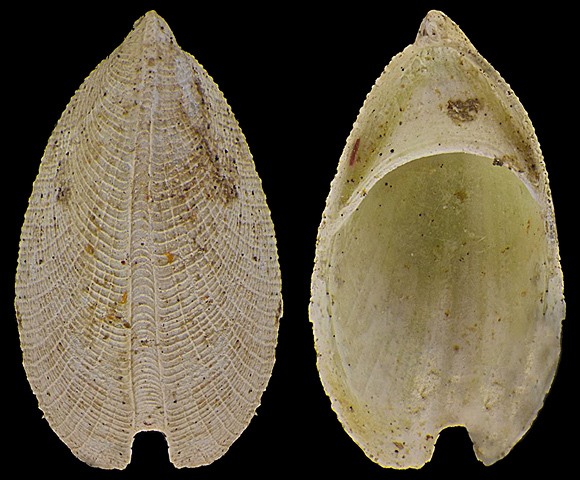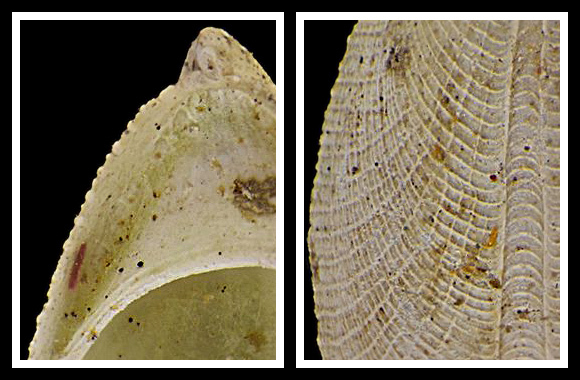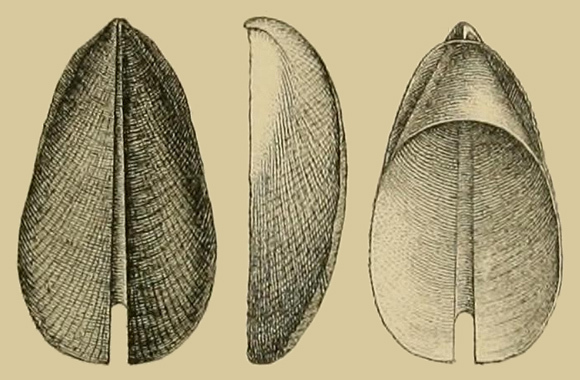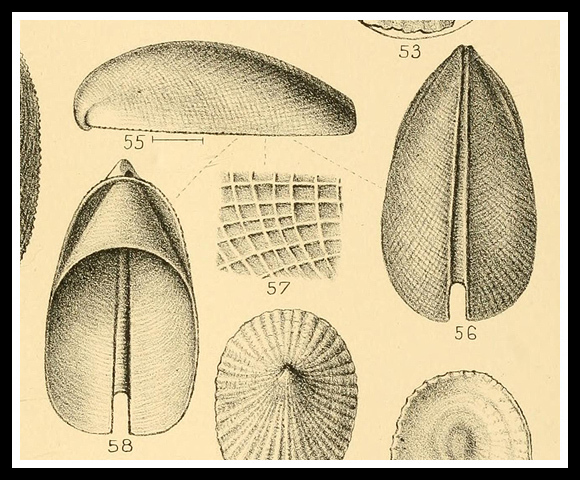
Amphiatlantic: Puerto Rico area and Martinique, Isla de Alborán, Sardinia (Fasulo & Sorbi, 1977), in the circalittoral (Alghero, 80m) down to the continental shelf and slope (390fm for the holotype from the Virgin Islands, 874fm in the Azores).
The shell is « white, delicate, depressed, oblong, pointed behind, with a minute short apex, rounded and cleft in front, with a broad flat keel bearing the old cleft-scar and extending the whole length of the shell. The enormous mouth is closed behind by a crepidula-like partition. Sculpture: longitudinals — from the apex to the cleft across the middle of the back runs a broad raised keel, flat on the top, where it is scored by the minute delicate, sharp, prominent, close-set, but not contiguous scars of the old cleft; on either side it is bordered by a sharp marginal line; from these marginal lines branch off feeble irregular diverging threadlets, between which, as they go wider apart, others arise; the intervals between them are two to three times the breadth of the threadlets. Spirals — strictly speaking there are none, but the whole surface is scored at right angles to the longitudinals with a series of threadlets, very similar in form but rather more closely set; these radiate from the apex and indicate the old mouth-edges. » – R. B. Watson: “Mollusca of H.M.S. ‘Challenger’ Expedition”, Journal of the Linnean Society of London vol. 17, London 1883, p.27.
The shell is « white, delicate, depressed, oblong, pointed behind, with a minute short apex, rounded and cleft in front, with a broad flat keel bearing the old cleft-scar and extending the whole length of the shell. The enormous mouth is closed behind by a crepidula-like partition. Sculpture: longitudinals — from the apex to the cleft across the middle of the back runs a broad raised keel, flat on the top, where it is scored by the minute delicate, sharp, prominent, close-set, but not contiguous scars of the old cleft; on either side it is bordered by a sharp marginal line; from these marginal lines branch off feeble irregular diverging threadlets, between which, as they go wider apart, others arise; the intervals between them are two to three times the breadth of the threadlets. Spirals — strictly speaking there are none, but the whole surface is scored at right angles to the longitudinals with a series of threadlets, very similar in form but rather more closely set; these radiate from the apex and indicate the old mouth-edges. » – R. B. Watson: “Mollusca of H.M.S. ‘Challenger’ Expedition”, Journal of the Linnean Society of London vol. 17, London 1883, p.27.
Above and below:
120-180m deep, Isla de Alborán. 5,6mm.
Original pictures provided by A. Nappo (IT).
– (CC BY-NC-SA) –

« At the posterior end of the shell there is a narrow, rounded, prominent beak, within which, a little bent to the right and projecting slightly above the margin of the mouth, is the minute apex of one whorl. Mouth oblong. Margin minutely denticulated by the ends of the ribs […] Inside glossy, smooth; a strong depression corresponding to the exterior keel extends from end to end of the shell. Septum — a little way within the margin, and deepest at the end, is the short oblique septum, which is faintly arched, with a concave edge in front. » – Op. cit. p.28.

